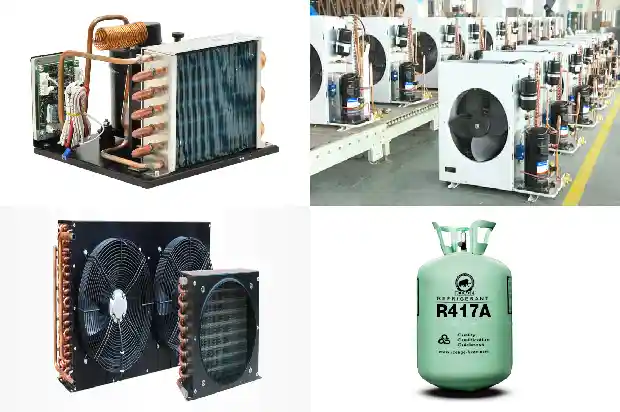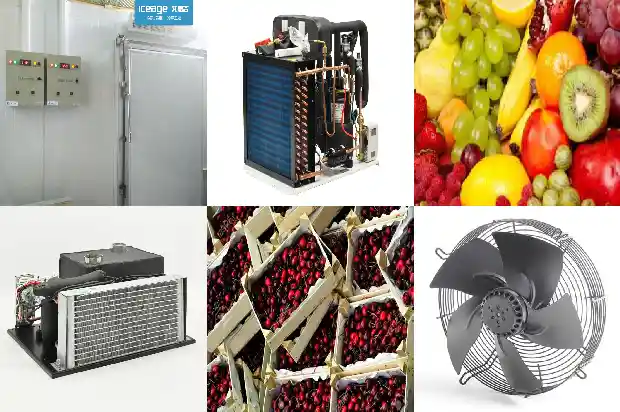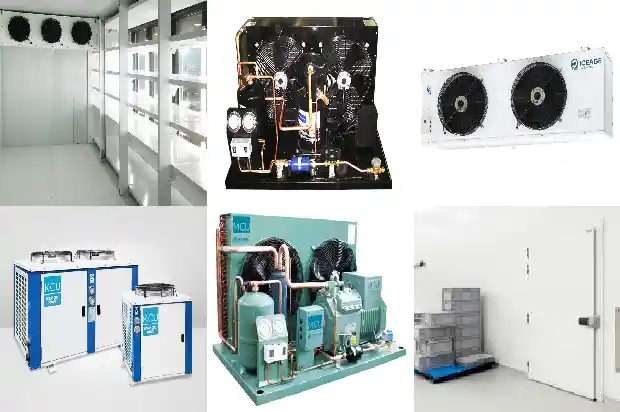What is the Impact of Cooling Fan Evaporator Fin Spacing on Frost Formation?
2025-02-25
As a commonly used evaporator in the refrigeration system, whether the selection of the cooling fan is appropriate directly affects the efficiency of the refrigeration system. As is known to all, cooling fans adopt different fin spacings according to different required ambient temperatures.
For the cooling fans we commonly see, the fin spacings include 4mm, 4.5mm, 6 - 8mm, 10mm, 12mm, and there are also those with variable fin spacings at the front and back. A small fin spacing is suitable for high - temperature environments; the lower the temperature of the cold storage, the larger the required fin spacing. If the selection is unreasonable, the fins will frost quickly, soon blocking the air passage. As a result, it will be difficult to lower the temperature of the cold storage, the efficiency of the compressor cannot be fully utilized, and the power consumption of the refrigeration system will increase.
Generally, for environments with temperatures ranging from 0°C to 20°C, such as workshop air - conditioners, cool storage rooms, cold storage corridors, fresh - keeping storages, controlled - atmosphere storages, and ripening storages, cooling fans with a fin spacing of 4mm or 4.5mm are selected. For environments with temperatures from - 16°C to - 25°C, such as low - temperature freezing and cold - storage rooms, and low - temperature logistics storages, cooling fans with a fin spacing of 6mm - 8mm are chosen. For quick - freezing storages with temperatures from - 25°C to - 35°C, cooling fans with a fin spacing of 10mm and 12mm are generally selected. If the goods to be quickly frozen have a high humidity, variable - fin - spacing cooling fans will be chosen, and the fin spacing on the air - inlet side can reach 16mm.

However, in some cases, the fin spacing of the cooling fan cannot be selected solely according to the temperature. For example, in the rapid precooling and acid - removal processes of meat and vegetables, although the temperature of the cold room is generally set above 0°C, due to the high incoming - goods temperature, fast cooling speed, and high humidity of the goods, it is not suitable to select a cooling fan with a fin spacing of 4mm or 4.5mm.

There are also fresh - keeping storages similar to those for storing fruits and vegetables such as garlic and apples. The suitable storage temperature is generally around - 2°C. For fresh - keeping or controlled - atmosphere storages with a storage temperature lower than 0°C, a cooling fan with a fin spacing of not less than 8mm also needs to be selected to avoid the rapid frosting that can cause the blockage of the air duct and an increase in power consumption.
The impact of frost on the refrigeration system:
When the refrigeration system of the cold storage is operating normally, the surface temperature of the evaporator is much lower than the dew - point temperature of the air, and the moisture in the air will precipitate and condense on the pipe wall. If the pipe - wall temperature is lower than 0°C, the water droplets will freeze into frost. Frost formation is also the result of the normal operation of the refrigeration system, so a small amount of frost on the surface of the evaporator is allowed.
Because the thermal conductivity of frost is too small, it is only one - hundredth or even one - several - hundredth of that of metal, so the frost layer forms a relatively large thermal resistance. Especially when the frost layer is thick, it is like insulation, making it difficult for the cold in the evaporator to be dissipated, affecting the refrigeration effect of the evaporator, and ultimately preventing the cold storage from reaching the required temperature. At the same time, the evaporation of the refrigerant in the evaporator will also be weakened.
When the refrigeration system of the cold storage is operating normally, the surface temperature of the evaporator is much lower than the dew - point temperature of the air, and the moisture in the air will precipitate and condense on the pipe wall. If the pipe - wall temperature is lower than 0°C, the water droplets will freeze into frost. Frost formation is also the result of the normal operation of the refrigeration system, so a small amount of frost on the surface of the evaporator is allowed.
Because the thermal conductivity of frost is too small, it is only one - hundredth or even one - several - hundredth of that of metal, so the frost layer forms a relatively large thermal resistance. Especially when the frost layer is thick, it is like insulation, making it difficult for the cold in the evaporator to be dissipated, affecting the refrigeration effect of the evaporator, and ultimately preventing the cold storage from reaching the required temperature. At the same time, the evaporation of the refrigerant in the evaporator will also be weakened.


Related Articles
- What Impact Does Pressure Have on the Refrigeration System?
- Causes and Prevention of "Primary Condensation" and "Secondary Condensation" in Fan - Coil Units
- What Should Be Done When the Condenser Fan Doesn't Rotate During Operation?
- How to Choose the Bearings of Cooling Fans?
- What are the characteristics and application fields of cross-flow fans?
- How to Choose an Air Purifier Cooling Fan
- Common Faults of HVAC Fan Coil Units
- Cooling fan introduction of the fan
- Influence of Fin Spacing of Evaporator in Air Cooler on Frost Formation
- Liquid Level Detection and Control of Flooded Evaporators
- Technology: Dry, Flooded and Falling Film Evaporators!
- All-round Introduction to Condensers and Evaporators!
- Common Causes of Frost Build-up in refrigerant evaporators
- Evaporator Three Ways of Feeding Liquids
- Fin Spacing Design of Cooler and Several Knowledge Points of Defrosting in Cold Storage
- Defrosting Heating Tubes in Refrigeration Devices
- Reasons for Frost Formation in Cold Storage and Defrosting Methods
- Frosting and Defrosting Issues of Air - cooled Heat Pumps
